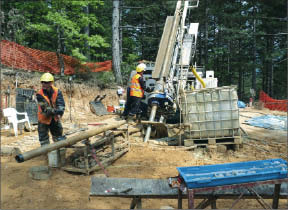Gold miner Alamos Gold (AGI-T) has delineated a new gold zone near its Agi Dagi gold project in Turkey that it believes has the potential to develop into a “stand-alone” project, according to a company news release dated June 16.
Called the Camyurt project, the new area of mineralization was found 3 km southeast of the main Agi Dagi deposit, which is currently at the prefeasibility stage. Recently released assays from the new zone include a 185.7-metre intersection grading 1.6 grams gold per tonne, as well as 89.6 metres at 2.34 grams gold.
Alamos says gold mineralization at Camyurt is continuous for at least 700 metres along strike and at least 200 metres deep. It further notes the zone is open at depth and has a potential 600-metre southwest strike extension that is currently being drill-tested. The company has completed 3,400 metres of a planned 10,000-metre drill program at Camyurt for 2011, part of a larger 30,000-metre program for all its projects in Turkey.
The Toronto-based miner, which also owns and operates the highly profitable Mulatos gold mine in northwest Mexico, acquired Agi Dagi and a few other Turkish projects in 2009 from Teck Resources (TCK-T, TCK-N) and Fronteer Development Group, which Newmont Mining (NEM-N, NMC-T) took over in early 2011. Alamos paid 4 million shares and US$40 million cash to buy the Turkish units, securing a decent price according to several analysts by purchasing the assets at a time when Teck was unloading its gold positions and Fronteer needed the money for its main projects in Nevada. Increasing political risk in Turkey may also have been a deciding factor.
The Camyurt zone was originally discovered by Teck and Fronteer in late 2007, when they drilled five widely spaced core holes there. Although the holes had poor core recovery and one was abandoned during drilling, significant mineralization was found, including 73.3 metres grading 0.65 gram gold per tonne with an average core recovery of 43%.
Alamos drilled six core holes in the area during the fourth quarter of 2010 to follow up on the previous operators’ results, encountering 58.9 metres grading 1.33 grams gold in a hole twinned with the one listed above. Core recovery was much improved at 82%. The company has since drilled an additional 10,000 metres at Camyurt in 2011 to extend the strike length of the known body of gold mineralization and target areas it believed were undershot by previous holes, resulting in the recently released intersections.
Alamos says all reported intervals represent oxidized mineralization, except for a few minor intervals of sulphide near the end of the deeper holes. An encouraging 1,200-metre-long silica anomaly coincides with strong gold-in-soil values over the mineralized area, which is interpreted to be from sub-vertical oxidized volcanic and breccia structures. Outcropping rocks are intensely silicified, with vuggy silica present and numerous surface workings.
The company has two core drill rigs operating at Camyurt and hopes to include the zone in its year-end 2011 global resource and reserve statement, though it is unlikely to be included in the highly anticipated prefeasibility study for Agi Dagi and the nearby Kirazli gold project, expected by December 2011.
Alamos planned to release the prefeasibility study during the second quarter of this year, but ran into delays in obtaining drill permits, such as needing to conduct additional geotechnical and condemnation drilling.
The company’s project development timeline remains unchanged. Initial production from Kirazli is expected in the first quarter of 2013 followed by Agi Dagi a year later, assuming timely approval of environmental and mining permits.
A preliminary economic assessment for Agi Dagi and Kirazli completed by Alamos in early 2010 outlined an operation with annual production of 135,000 oz. gold and 621,600 oz. silver over the first eight years. Using a base-case
scenario of US$800 per oz. gold and US$13.5 per oz. silver, Alamos expects the projects’ capital expenditure to run US$235 million, with cash costs averaging US$314 per oz. gold net of silver by-product credits.
The company plans to provide an updated mineral resource estimate for Agi Dagi and Kirazli in the third quarter, which will include all of the drilling completed at the projects up to March 2011.
Alamos shares closed 5¢ on 647,000 shares traded following the drill-result announcement. The down-day for markets saw a wide sell-off in both the S&P/TSX Global Gold Index and other equities.


Be the first to comment on "Alamos drills new gold zone near Agi Dagi"